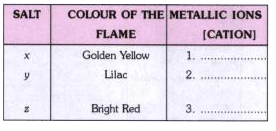_______ burns with a non-luminous flame. (butane/methane/acetylene).
To solve the question "_______ burns with a non-luminous flame. (butane/methane/acetylene)", we can follow these steps:
Step 1: Identify the Compounds
We have three options to consider:
- Butane (C4H10)
- Methane (CH4)
- Acetylene (C2H2)
Step 2: Determine the Type of Hydrocarbons
- Butane (C4H10) and Methane (CH4) are both alkanes, which follow the general formula CnH2n+2. They are saturated hydrocarbons.
- Acetylene (C2H2) is an alkyne, which follows the general formula CnH2n-2. It is an unsaturated hydrocarbon.
Step 3: Analyze the Combustion of Each Compound
- Saturated Hydrocarbons (Butane and Methane): These compounds burn completely in oxygen, producing carbon dioxide and water, and they produce a luminous flame (bright and visible).
- Unsaturated Hydrocarbons (Acetylene): This compound does not burn completely due to the presence of double or triple bonds. It undergoes incomplete combustion, resulting in a non-luminous flame (sooty flame).
Step 4: Conclusion
From the analysis, we can conclude that Acetylene is the compound that burns with a non-luminous flame.
Final Answer
Acetylene burns with a non-luminous flame.
---
We have three options to consider:
- Butane (C4H10)
- Methane (CH4)
- Acetylene (C2H2)
- Butane (C4H10) and Methane (CH4) are both alkanes, which follow the general formula CnH2n+2. They are saturated hydrocarbons.
- Acetylene (C2H2) is an alkyne, which follows the general formula CnH2n-2. It is an unsaturated hydrocarbon.
- Saturated Hydrocarbons (Butane and Methane): These compounds burn completely in oxygen, producing carbon dioxide and water, and they produce a luminous flame (bright and visible).
- Unsaturated Hydrocarbons (Acetylene): This compound does not burn completely due to the presence of double or triple bonds. It undergoes incomplete combustion, resulting in a non-luminous flame (sooty flame).
From the analysis, we can conclude that Acetylene is the compound that burns with a non-luminous flame.
Acetylene burns with a non-luminous flame.
Topper's Solved these Questions
- SELF ASSESSMENT PAPER 1BOOK - ICSECHAPTER - SELF ASSESSMENT PAPER 1EXERCISE - SECTION-II
49 Videos
- SELF ASSESSMENT PAPER 05BOOK - ICSECHAPTER - SELF ASSESSMENT PAPER 05EXERCISE - SECTION II (Fill in the blanks with the choice given in the brackets. )
5 Videos
- SELF ASSESSMENT PAPER 2 BOOK - ICSECHAPTER - SELF ASSESSMENT PAPER 2 EXERCISE - SECTION-II
45 Videos
Similar Questions
Benzene burns with a luminous flame.
View SolutionAlkanes burn with a smoky flame.
View SolutionMagnesium burns with a _____ flame.
View SolutionA gas which burns with blue flame is
View SolutionConversion of Methane into acetylene
View SolutionMonosilane on coming in contact with air burns with a luminous flame producing vortex rings. These rings are of
View SolutionThe metallic ions (the cations) can be identify by performing flame test which is describe below.
"Make a paste of the given salt in concentrated hydrochloric acid. Load the paste on a clean platinum wire and introduce it in a non-luminous bunsen burner flame. Note the colour of the flame imparted by the flame. Tabulate your answer in the formate given below. The salt x imparts golden yellow flame. The salt y imparts lilac flame and the salt z imparts bright red flame.

View SolutionA chemistry student trying to detect the metallic ion in a salt, makes a paste on a clean platinum wire loop of the salt with concentrated HCl. When he takes a small amount of this paste and keeps it in a non-luminous Bunsen flame, the colour of the flame changes to grassy green.He should, therefore, conclude that the metal is
View Solutiona. While testing oxalate, gas obtained burns with a blue flame intially but is put off instantly even as gas appears coming. Explain.
b. IΘ also interfere in the 'Ring Test' of NOΘ3 suggest a chemical reagent that removed IΘ
View Solution
How can a non-luminous metal such as iron be made luminous?
View Solution
